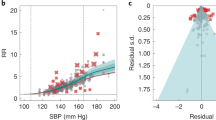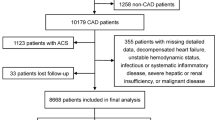Abstract
Although pharmacological treatments of hypertension and dyslipidaemia are both associated with a reduction in cardiovascular risk, little is known about the degree of cardiovascular risk remaining in treated individuals, by assessing the levels of their risk factors achieved, that is their ‘residual cardiovascular risk’. We then used the data from the Prospective Epidemiological Study of Myocardial Infarction (PRIME), which involved 9649 men aged 50–59 years, from France and Northern Ireland with a 10-year follow-up, to test the presence of specific residual cardiovascular risks of coronary heart disease, stroke, total of fatal and non-fatal cardiovascular events and cardiovascular mortality, in patients treated with antihypertensive agents or lipid-lowering agents. In the whole cohort, a total of 796 patients developed a fatal or non-fatal cardiovascular event. Antihypertensive drug use at baseline was significantly associated (RR=1.50, 95% CI: 1.25–1.80) with total cardiovascular event risk, but not lipid-lowering drug use, after adjusting for classic risk factors (age, smoking, total cholesterol, high-density lipoprotein cholesterol, systolic blood pressure and diabetes). Similar results were obtained for coronary heart disease (RR=1.46, 95% CI: 1.18–1.80), stroke (RR=1.75, 95% CI: 1.14–2.70) and cardiovascular death (RR=1.62, 95% CI: 1.02–2.58), but neither for total death (RR=1.15, 95% CI: 0.89–1.48) nor for non-cardiovascular death (RR=1.00, 95% CI: 0.74–1.36). For any cardiovascular end point, residual risks did not globally differ according to the antihypertensive drug class prescribed at baseline. In conclusion, treatment with antihypertensive agents, but not with lipid-lowering agents, was associated with a sizeable residual cardiovascular risk, suggesting that more efficient risk reduction strategies in hypertension should be developed as a priority.
This is a preview of subscription content, access via your institution
Access options
Subscribe to this journal
Receive 12 digital issues and online access to articles
$119.00 per year
only $9.92 per issue
Buy this article
- Purchase on Springer Link
- Instant access to full article PDF
Prices may be subject to local taxes which are calculated during checkout

Similar content being viewed by others
References
Lauer MS . Clinical epidemiology, clinical care, and the public's health. Mayo Clin Proc 2004; 79: 983–991.
MacMahon S, Peto R, Cutler J, Collins R, Sorlie P, Neaton J et al. Blood pressure, stroke, and coronary heart disease. Part 1, prolonged differences in blood pressure: prospective observational studies corrected for the regression dilution bias. Lancet 1990; 335: 765–774.
Collins R, Peto R, MacMahon S, Hebert P, Fiebach NH, Eberlein KA et al. Blood pressure, stroke and coronary heart disease. Part 2, short term reductions in blood pressure: overview of randomised drug trials in their epidemiological context. Lancet 1990; 335: 827–838.
Andersson OK, Almgren T, Persson B, Samuelsson O, Hedner T, Wilhelmsen L . Survival in treated hypertension: follow up study after two decades. BMJ 1998; 317: 167–171.
Glynn RJ, L'Italien GJ, Sesso HD, Jackson EA, Buring JE . Development of predictive models for long-term cardiovascular risk associated with systolic and diastolic blood pressure. Hypertension 2002; 39: 105–110.
NCEP. Executive summary of the third report of the National Cholesterol Education Program (NCEP) expert panel on detection, evaluation, and treatment of high blood cholesterol in adults (adult treatment panel III). JAMA 2001; 285: 2486–2497.
Blacher J, Evans A, Arveiler D, Amouyel P, Ferrières J, Bingham A, et al., on behalf of the PRIME Study Group. Residual coronary risk in men aged 50–59 treated for hypertension and hyperlipidemia in the population. The PRIME study. J Hypertens 2004; 22: 415–423.
D'Agostino Sr RB, Vasan RS, Pencina MJ, Wolf PA, Cobain M, Massaro JM et al. General cardiovascular risk profile for use in primary care: the Framingham Heart Study. Circulation 2008; 117: 743–753.
Hippisley-Cox J, Coupland C, Vinogradova Y, Robson J, May M, Brindle P . Derivation and validation of QRISK, a new cardiovascular disease risk score for the United Kingdom: prospective open cohort study. BMJ 2007; 335: 136–147.
Zethelius B, Berglund L, Sundström J, Ingelsson E, Basu S, Larsson A et al. Use of multiple biomarkers to improve the prediction of death from cardiovascular causes. N Engl J Med 2008; 358: 2107–2116.
Yarnell JWG, for the PRIME Study Group. The PRIME study: classical risk factors do not explain the severalfold differences in risk of coronary heart disease between France and Northern Ireland. Q J Med 1998; 91: 667–676.
Ducimetière P, Ruidavets JB, Montaye M, Haas B, Yarnell J, on behalf of the PRIME Study Group. Five-year incidence of angina pectoris and other forms of coronary heart disease in healthy men aged 50–59 in France and Northern Ireland: the PRIME study. Int J Epidemiol 2001; 30: 1057–1062.
Rose GA, Blackburn H, Gillum RF, Prineas RJ . Cardiovascular Survey Methods, 2nd edn. WHO: Geneva, 1982.
Tunstall-Pedoe H, Kuulasmaa K, Amouyel P, Arveiler D, Rajakangas A-M, Pajak A, for WHO MONICA Project. Myocardial infarction and coronary deaths in the World Health Organization MONICA Project. Registration procedures, event rates and case fatality in 38 populations from 21 countries in 4 continents. Circulation 1994; 90: 583–612.
Mancia G, De Backer G, Dominiczak A, Cifkova R, Fagard R, Germano G et al. Management of arterial hypertension of the European Society of Hypertension; European Society of Cardiology. 2007 guidelines for the management of arterial hypertension: the task force for the management of arterial hypertension of the European Society of Hypertension (ESH) and of the European Society of Cardiology (ESC). J Hypertens 2007; 25: 1105–1187.
Lindholm LH, Carlberg B, Samuelsson O . Should beta-blockers remain first choice in the treatment of primary hypertension? A meta-analysis. Lancet 2005; 366: 1545–1553.
Verdecchia P, Reboldi G, Angeli F, Gattobigio R, Bentivoglio M, Thijs L et al. Angiotensin-converting enzyme inhibitors and calcium channel blockers for coronary heart disease and stroke prevention. Hypertension 2005; 46: 386–392.
Siscovick DS, Raghunathan TE, Psaty BM, Koepsell TD, Wicklund KG, Lin X et al. Diuretic therapy for hypertension and the risk of primary cardiac arrest. N Engl J Med 1994; 330: 1852–1857.
Turnbull F . Blood pressure lowering treatment trialists' collaboration. Effects of different blood-pressure-lowering regimens on major cardiovascular events: results of prospectively-designed overviews of randomised trials. Lancet 2003; 362: 1527–1535.
The ALLHAT Officers and Coordinators for the ALLHAT Collaborative Research Group. Major outcomes in high-risk hypertensive patients randomized to angiotensin-converting enzyme inhibitor or calcium channel blocker versus diuretic: the Antihypertensive and Lipid-Lowering Treatment to Prevent Heart Attack Trial (ALLHAT). JAMA 2002; 288: 2981–2997.
Takemoto M, Liao JK . Pleiotropic effects of 3-hydroxy-3-methylglutaryl coenzyme a reductase inhibitors. Arterioscler Thromb Vasc Biol 2001; 21: 1712–1719.
Cholesterol Treatment Trialists' (CTT) Collaborators. Efficacy and safety of cholesterol-lowering treatment: prospective meta-analysis of data from 90 056 participants in 14 randomised trials of statins. Lancet 2005; 366: 1267–1278.
Acknowledgements
We thank the following organizations that allowed the recruitment of the PRIME subjects: the Health screening Centres organized by the Social Security of Lille (Institut Pasteur), Strasbourg, Toulouse and Tourcoing; Occupational Medicine Services of Haute-Garonne, of the Urban Community of Strasbourg; the Association Interentreprises des Services Médicaux du Travail de Lille et environs; the Comité pour le Développement de la Médecine du Travail; the Mutuelle Générale des PTT du Bas-Rhin; the Laboratoire d'Analyses de l'Institut de Chimie Biologique de la Faculté de Médecine de Strasbourg; the Department of Health (NI) and the Northern Ireland Chest Heart and Stroke Association. We also thank the members of the event validation committees: Professor Louis Guize, Dr Caroline Morrison, Dr Marie-Thérèse Guillanneuf, Professor Maurice Giroud; and the Alliance Partnership Programme for its financial support. Pierre Ducimetière had full access to all of the data in the study and takes responsibility for the integrity of the data and the accuracy of the data analysis.
Author information
Authors and Affiliations
Consortia
Corresponding author
Appendix
Appendix
The PRIME Study Group
The PRIME Study is organized under an agreement between INSERM and the Merck Sharp and Dohme-Chibret Laboratory, with the following participating laboratories:
-
The Strasbourg MONICA Project, Laboratoire d'Epidemiologie et de Sante Publique, EA1801, Strasbourg, F-67085, France; Universite Louis Pasteur, Faculte de Medecine, Strasbourg, F-67085, France (D Arveiler and B Haas).
-
The Toulouse MONICA Project, INSERM U558, Departement d'Epidemiologie, Universite Paul Sabatier-Toulouse Purpan, Toulouse, France (J Ferrières and JB Ruidavets).
-
The Lille MONICA Project, INSERM U744, Lille, France; Institut Pasteur de Lille, Lille, France; Université de Lille 2, Lille, France (P Amouyel and M Montaye).
-
The Department of Epidemiology and Public Health, Queen's University Belfast, Belfast, Northern Ireland (A Evans, J Yarnell and F Kee).
-
The Department of Atherosclerosis, INSERM U545, Lille, France; Institut Pasteur de Lille, Lille, France; Université de Lille 2, Lille, France (G Luc and JM Bard).
-
The Laboratory of Haematology, INSERM U626, Marseille, Hôpital La Timone, Marseille, France (I Juhan-Vague and P Morange).
-
The Laboratory of Endocrinology, INSERM U563, Toulouse, France (B Perret).
-
The Vitamin Research Unit, The University of Bern, Bern, Switzerland (F Gey).
-
The Nutrition and Metabolism Group, Centre for Clinical and Population Sciences, Queen's University Belfast, Belfast, Northern Ireland (J Woodside and I Young).
-
The DNA Bank, INSERM U525, Paris, France (F Cambien).
-
The Coordinating Center, INSERM U780, Villejuif, F-94807, France; University Paris-Sud, Faculty of Medicine, Villejuif, F-94807, France (P Ducimetiere and A Bingham).
Rights and permissions
About this article
Cite this article
Blacher, J., Evans, A., Arveiler, D. et al. Residual cardiovascular risk in treated hypertension and hyperlipidaemia: the PRIME Study. J Hum Hypertens 24, 19–26 (2010). https://doi.org/10.1038/jhh.2009.34
Received:
Revised:
Accepted:
Published:
Issue Date:
DOI: https://doi.org/10.1038/jhh.2009.34
Keywords
This article is cited by
-
Multifactorial prevention program for cardiovascular disease in primary care: hypertension status and effect on mortality
Journal of Human Hypertension (2024)
-
Cardiovascular risk in patients receiving antihypertensive drug treatment from the perspective of endothelial function
Hypertension Research (2022)
-
Fluid-structure interaction simulation of tissue degradation and its effects on intra-aneurysm hemodynamics
Biomechanics and Modeling in Mechanobiology (2022)
-
Anemia is an independent risk factor for cardiovascular and renal events in hypertensive outpatients with well-controlled blood pressure: a subgroup analysis of the ATTEMPT-CVD randomized trial
Hypertension Research (2019)
-
Big Data and Blood Pressure Control: Insights from the PAMELA and BP-CARE Study Cohorts
Current Hypertension Reports (2018)



